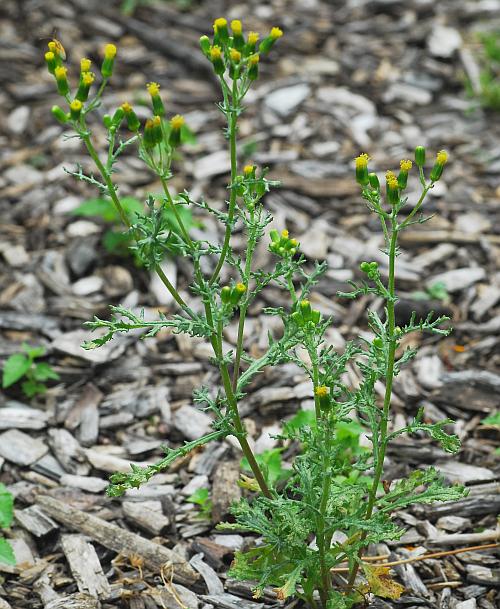Senecio vulgaris L.
Common Groundsel

Introduced
CC = *
CW = 5
MOC = 9
© DETenaglia
Senecio vulgaris L.Common Groundsel | |
 |
Introduced CC = * CW = 5 MOC = 9 |
© DETenaglia |
|
Family - Asteraceae/Senecioneae Habit - Taprooted annual forb. Stems - Ascending, often multiple from base and branching, to 40 cm, with fine, woolly (cobwebby) hairs when young, sometimes becoming nearly glabrous with age, often reddish-or purplish-tinged.
Leaves - Basal and alternate. Basal and lower leaves 2-10 cm long, the blades narrowly elliptic to narrowly obovate, irregularly pinnately lobed, mostly bluntly pointed at the tip, tapered at the base to a poorly defined petiole, the margins otherwise irregularly few-toothed or with a few secondary lobes, sparsely to moderately pubescent with cobwebby hairs or scattered, minute, curled hairs. Upper leaves sessile, narrowly ovate to narrowly oblong-elliptic, sessile and sometimes weakly auriculate or clasping, mostly pinnately lobed, the margins irregularly few-toothed, wavy, or rarely with a few secondary lobes.
Inflorescence - Terminal and axillary, paniculate, often compact clusters of flower heads, these often nodding.
Heads - Involucre 4-8 mm long, 5-6mm in diameter, the inner bracts 18-22, green with minute, black tips, the outer series occasionally extending slightly down the stalk, linear, green with minute, black tips.
Florets - Ray flowers absent. Disk flowers yellow at the apex, pale basally, 5-lobed, glabrous, 4-6 mm long, funnelform near the apex. Lobes rounded, erect to spreading, glabrous. Stamens 5, adnate near the apical 1/5 of the corolla tube, included to partially exserted. Anthers yellow-brown, connate around the style. Filaments white, glabrous. Style bifurcate, purplish at the apex (stigma), glabrous. Pappus of numerous capillary bristles. Fruits - Achenes 2-3 mm long, linear, terete, 9-nerved, brown, with short retrorse strigose pubescence.
Flowering - June - October. Habitat - Greenhouses, gardens, railroads, roadsides, and open disturbed areas. Origin - Native to Europe. Lookalikes - Flowering heads are similar to those of Erechtites hieraciifolius. Other info. - This little plant is fairly uncommon in Missouri, being found mainly at or near garden sites. It is spread primarily as weeds in potted plants, or in potting soil or mulch. It is found in widely scattered, sporadic populations throughout most of the continental U.S. It is easily identified by its pinnately lobed leaves, which are often cobwebby in places, and numerous small discoid heads with yellow florets. Photographs taken in Salter Path, NC., 3-1-03 (DETenaglia); also at Doetsch Ranch near the Columbia River, Skamania County, WA, 6-18-2015, and in St. Louis, St. Louis County, MO, 7-23-2015 (SRTurner). |